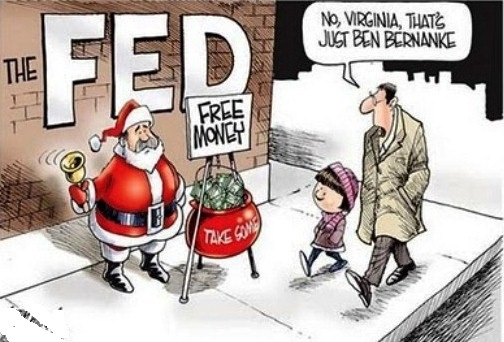
On September 13, 2012 the Federal Reserve Board of Governors announced their newest foray into monetary policy: Quantitative Easing Three (more commonly referred to as QE3). Benjamin Bernanke, the Chairman of the Federal Reserve, announced that the Fed would enact the policy starting immediately, and that this current round of Quantitative Easing would last until the Federal Reserve felt the economy had recovered. Since the Federal Reserve began its quantitative easing operations with QE1 in November 2008, the Federal Reserve has purchased $1.85 trillion in assets on the open market. These assets range from mortgage backed securities—a bond comprised of pooled mortgages and sold on the open market—to treasury bonds.
Quantitative easing is a form of monetary policy where a central bank–the Federal Reserve in the case of the United States–prints money to purchase long term assets such as long term US Government bonds or mortgage backed securities. The purchase of these assets injects money into the economy, and leads to a reduction in the long term interest rate, which in theory gives investors an incentive to spend their money.
The issue with this round of quantitative easing is that there is already so much money in the economy that adding any more will fail to accomplish QE3’s intended goals. Despite the admirable goals of the Federal Reserve with this policy, QE3 will not succeed because banks are still not loaning out money, and the policy has the potential to cause inflation in non-housing sectors of the economy which would negate any benefit that the policy may provide. In addition to these concerns, another issue with this policy is that unemployment is affected by many factors that are not within the mandate of the Federal Reserve’s operations.
To say that the American economy is stagnant would fail to describe just how drastic the problem is. Before September’s labor statistics were released, unemployment was above eight percent for 43 consecutive months. Economic growth is still slow, and return to pre-recession growth and job numbers remains distant.
Former Federal Reserve Chairman Paul Volker—the man who helped bring an end to stagflation of the 1980’s under the Reagan administration—argues that there is too much money in circulation for QE3 to succeed. Not only does this excess money pose a threat to the success of QE3, but it could also contribute to high inflation.
In 2010, after the announcement of QE2, the Federal Reserve Bank of Saint Louis published a report titled “The Downside of Quantitative Easing.” The report, written by Daniel Thornton, the Vice President and Economic Advisor of the bank, details the chain reaction that will result from QE3. QE3 will increase the money supply, which will likely lead to inflation.
Thornton makes another interesting point, which is of particular concern. “Currently, banks are content to hold massive amounts of excess reserves,” (Thornton, 1). If banks were to start making loans again, that would mean that there would be a large, unforeseen increase in the money supply, which would increase inflation far beyond the expected rates set forth by the Federal Reserve. This would be a major concern, as the last thing the American economy needs right now is to battle with inflation, in the midst of an anemic recovery.
Furthermore, with the slow economic growth that is expected both at home and abroad for this year, as well as next year, it is clear that the recovery is far from over. It has become obvious that despite the best efforts of the Federal Reserve, its current policies have failed to spur economic growth.
When QE3 was announced, there was a lone dissenting vote against the policy. The man who dissented in Jeffrey Lacker, the head of the Federal Reserve Bank of Richmond since 2004. In the days after the announcement, Lacker argued that QE3 will not help the American economy, and moreover that it may not be within the mandate of the Federal Reserve. “I strongly opposed purchasing additional agency mortgage- backed securities, such purchases, as compared to purchases of an equivalent amount of U.S. Treasury securities, distort investment allocations and raise interest rates for other borrowers.” Lacker’s statement raises concern that QE3 will do the exact opposite of what it is intended to do, which is to bring stability to the economy and spur investment. If interest rates were to go up in non-housing sectors of the economy, that would counteract any positive gains from QE3.
Furthermore, Mr. Lacker argues that unemployment is affected by factors that cannot be controlled by monetary policy. “The behavior of inflation is fundamentally attributable to the actions of the central bank, while growth and labor market conditions are affected by a wide variety of factors.” While the Federal Reserve has a dual mandate to keep both unemployment and inflation low, any form of quantitative easing is not going to be comprehensive enough to be able to remedy the issue of unemployment here in the United States. Lacker argues that this does not mean that monetary policy has failed, but rather that there is a limit to the effect monetary policy has on unemployment. Lacker’s argument makes sense; after all, the Federal Reserve does not have the authority to force companies to hire workers, nor can they create government programs to provide jobs for the unemployed.
Columbia University professor Michael Woodford argues that quantitative easing has become necessary due to record low interest rates, “but in the wake of the global financial crisis, other central banks, notably including the Federal Reserve, have found that even reductions of their policy interest rates to the lowest levels that they are willing to contemplate have been insufficient to spur satisfactory recoveries” (Woodford, 4). Woodford also calls into question the efficiency of quantitative easing actions, especially those taken by the Bank of Japan from 2001-2006, where their money supply was increased by 75 percent, yet nominal GDP growth was only five percent over that five year period.
History as well as research have shown that quantitative easing is not as effective as the Federal Reserve would like the American people to believe. Despite massive growth in the monetary supply in Japan, nominal GDP increased by an average of one percent per year. This cannot bring any country out of a recession, especially a nation with an economy as large as Japan’s, or the United States’ for that matter. Furthermore, Mr. Thornton’s paper has shown that the risk of inflation is present in any quantitative easing actions. This is something that would dismantle any semblance of an economic recovery going on in the United States right now, as it would reduce the value of the dollar, hurting domestic consumption which is still depressed from the economic collapse of 2008. Additionally, high inflation creates an environment of uncertainty, which the US has struggled to deal with during the recovery.
Although Professor Woodford ultimately advocates utilizing quantitative easing policies by the Federal Reserve, there are still enough concerns with the policy as a whole that warrant a second look at its cost and effectiveness. At some point, Congress and the public need to realize that the expansion of the monetary base cannot bring the American economy out of recession. It is the author’s opinion that Congress and the President need to begin taking substantial actions to reassure the American people that they are solving–or at least trying to solve–the current economic crisis. The American people deserve more than political posturing and rhetoric. At the same time, the American people also deserve more than having to rely on Benjamin Bernanke to take action, however inefficient it may be, to try and restore normalcy to the U.S. economy.
Cameron Eide
International Affairs-Economics ‘16
Woodford’s Paper
http://kansascityfed.org/publicat/sympos/2012/mw.pdf?sm=jh083112-4
Thornton’s Paper
http://research.stlouisfed.org/publications/es/10/ES1034.pdf
Lacker Quote (Investment Distortions):
http://www.bloomberg.com/news/2012-09-15/fed-s-lacker-opposed-qe3-as-tantamount-to-fiscal-policy.html
Lacker Quote (Inflation vs Unemployment factors):
http://www.nytimes.com/reuters/2012/10/15/business/15reuters-usa-fed.html?ref=quantitativeeasing


